
Korean cuisine has evolved through centuries of social and political change. Originating from ancient agricultural and nomadic traditions in Korea and southern Manchuria, Korean cuisine reflects a complex interaction of the natural environment and different cultural trends.

Miso is a traditional Japanese seasoning. It is a thick paste produced by fermenting soybeans with salt and kōji and sometimes rice, barley, seaweed, or other ingredients. It is used for sauces and spreads, pickling vegetables, fish, or meats, and mixing with dashi soup stock to serve as miso soup, a Japanese culinary staple. Miso is high in protein and rich in vitamins and minerals, and it played an important nutritional role in feudal Japan. Miso is still widely used in both traditional and modern cooking in Japan and has been gaining worldwide interest.
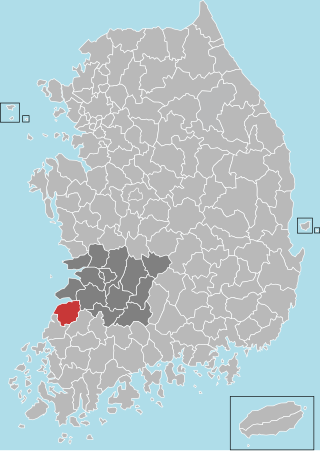
Gochang County is a county in North Jeolla Province, South Korea. It is a rural area, and is home to only one institution of higher education: Gochang Polytechnic College.

Andong is a city in South Korea, and the capital of North Gyeongsang Province. It is the largest city in the northern part of the province with a population of 167,821 as of October 2010. The Nakdong River flows through the city. Andong is a market centre for the surrounding agricultural areas.

Gochujang or red chili paste is a savory, sweet, and spicy fermented condiment popular in Korean cooking. It is made from gochu-garu, glutinous rice, meju powder, yeotgireum, and salt. The sweetness comes from the starch of cooked glutinous rice, cultured with saccharifying enzymes during the fermentation process. Traditionally, it would be naturally fermented over years in jangdok (earthenware) on an elevated stone platform called jangdokdae in the backyard.

Korean royal court cuisine was the style of cookery within Korean cuisine traditionally consumed at the court of the Joseon Dynasty, which ruled Korea from 1392 to 1910. There has been a revival of this cookery style in the 21st century. It is said that twelve dishes should be served along with rice and soup, with most dishes served in bangjja (bronzeware).
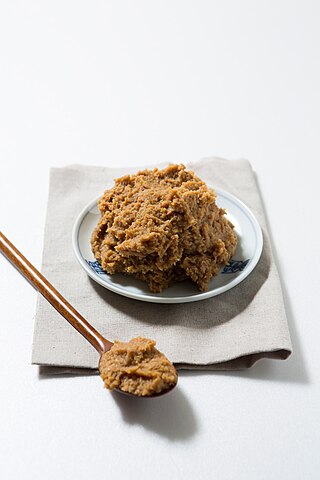
Doenjang or soybean paste is a type of fermented bean paste made entirely of soybean and brine used in Korean cuisine. It is also a byproduct of soup soy sauce production. It is sometimes used as a relish.
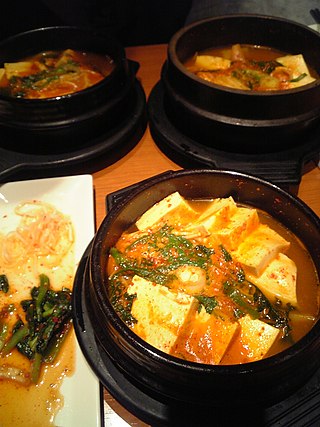
Jjigae are Korean stews. There are many varieties; they are typically made with meat, seafood or vegetables in a broth seasoned with gochujang, doenjang, ganjang or saeu-jeot. Jjigae is often served as a communal dish.

Chili sauce and chili paste are condiments prepared with chili peppers.

Banchan are small side dishes served along with cooked rice in Korean cuisine. Banchan are set in the middle of the table to be shared. At the center of the table is the secondary main course, such as galbi or bulgogi, and a shared pot of jjigae. Bowls of cooked rice and guk (soup) are set individually. Banchan are served in small portions, meant to be finished at each meal and replenished during the meal if not enough. Usually, the more formal the meals are, the more banchan there will be. Jeolla province is particularly famous for serving many different varieties of banchan in a single meal.
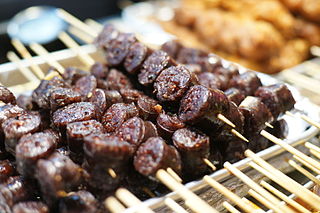
Sundae is a type of blood sausage in Korean cuisine. It is a popular street food in both North and South Korea, generally made by steaming cow or pig's intestines stuffed with various ingredients.

Ssamjang is a thick, spicy paste used with food wrapped in a leaf in Korean cuisine. The sauce is made of fermented soy beans (doenjang), red chili paste (gochujang), sesame oil, onion, garlic, green onions, and optionally brown sugar.

Doenjang-jjigae, referred to in English as soybean paste stew, is a Korean traditional jjigae, made from the primary ingredient of doenjang, and additional optional ingredients vegetables, seafood, and meat. It is one of the most iconic and popular traditional dishes in Korean cuisine, and is often eaten regularly regardless of occasion or time of day. Doenjang-jjigae was initially made with home-made doenjang; however, due to extensive industrialisation of soybean paste, households and restaurants nowadays use factory-made doenjang instead as their ingredient. From traditional to modern Korean cuisine, doenjang has become one of the most frequently used jang (sauce/paste). It is claimed as a national dish.

Meju (메주) is a brick of dried fermented soybeans. While not consumed on its own, it serves as the basis of several Korean condiments, such as doenjang, ganjang, and gochujang. Meju is produced by pounding, kneading, and shaping cooked soybeans, and undergoes fermentation with Aspergillus oryzae and/or Bacillus subtilis.
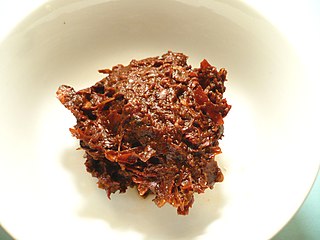
Doubanjiang, also known as douban, toban-djan, broad bean chili sauce, or fermented chili bean paste, is a hot and savoury Chinese bean paste made from fermented broad beans, chili peppers, soybeans, salt and flour. Characteristically used in Sichuan cuisine, it has been called "the soul of Sichuan cuisine." Sichuan dishes such as mapo tofu, huoguo, the Yuxiang flavour profile, and Shuizhu all use doubanjiang as a key ingredient. Other regions have their own versions: in Guangdong and Taiwan, for instance, the Sichuan doubanjiang is called la-doubanjiang to distinguish it from local non-spicy versions.

Doenjang-guk (Korean: 된장국) or soybean paste soup is a guk (soup) made with doenjang and other ingredients, such as vegetables, meat, and seafood. It is thinner, lighter, and milder than doenjang-jjigae. It is similar to the Japanese miso soup. It is sometimes mild, sometimes strong, and accompanied with rice most of the time.
The Food Festivals of South Korea are a series of celebrations that provide insight into Korea's cuisine and culture. The cuisine ranges from traditional dishes through to modern interpretations and will often focus on regionally specific recipes and ingredients. They seek to retain Korean cultural identity, raise awareness, and promote local produce, cuisine, and the Korean food industry. Over time, some festivals and dishes such as Chimaek have become part of modern Korean culture and were further popularized by K-dramas.


















